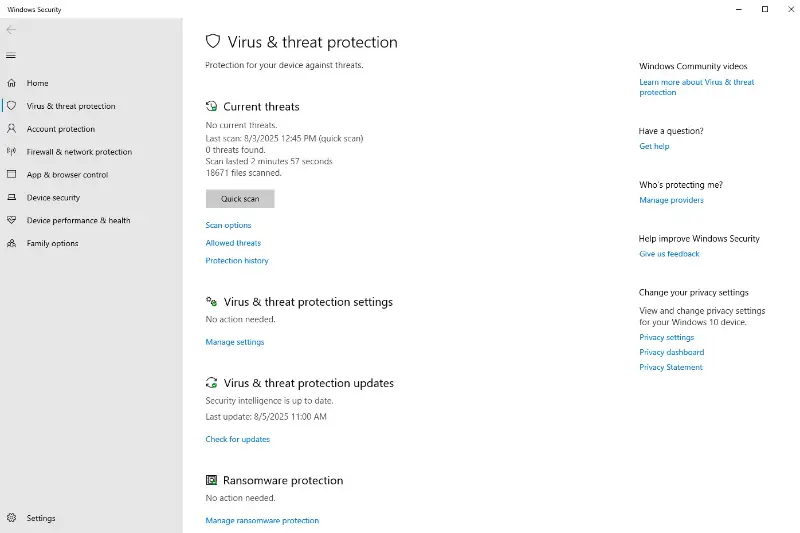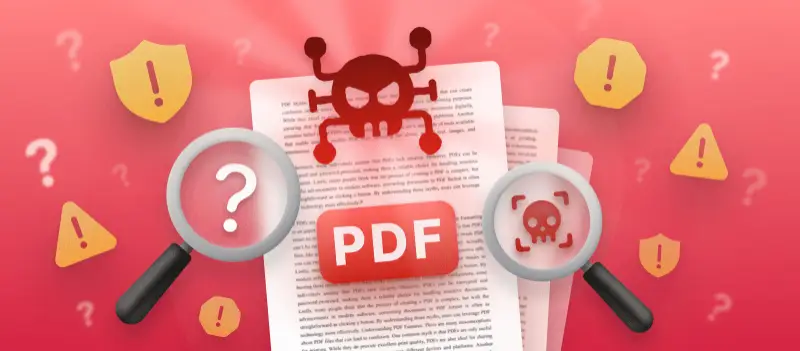Can a PDF have a virus is a question many users ask when downloading documents from unknown sources.
While the PDF format is generally considered safe, they can be exploited by cybercriminals to deliver malicious code, phishing attempts, or hidden malware.
This article explains how can opening a PDF be dangerous, the signs to watch out for, and the best practices to keep your system secure.
Can PDFs have viruses?
PDFs are often perceived as harmless because they are primarily employed for sharing text and images. However, their complex structure and interactive capabilities can be manipulated by attackers to deliver malware.
Here’s how these threats find their way into seemingly legitimate documents.
Hidden Malicious Code Inside PDFs
Unlike simple text files, PDFs support scripts, multimedia, and dynamic content. This flexibility allows hackers to inject harmful elements into the paper, which may activate when opened.
For example:
- Scripts embedded in the document can exploit vulnerabilities in outdated PDF readers.
- Executable payloads may be disguised within the structure, staying dormant until triggered.
- Encrypted sections or compressed streams can hide malicious data, making detection harder for basic security tools.
Fact: Even a PDF that looks empty or contains only a few lines of text can carry complex code capable of compromising a system.
Common Attack Techniques
Cybercriminals utilize several methods to weaponize malicious PDFs. The most widespread include:
1. JavaScript Exploits
Some PDF readers allow JavaScript for interactive forms and automation. Hackers abuse this feature by embedding scripts that:
- Run automatically when the file opens.
- Exploit security flaws in the viewer to install malware.
- Redirect you to compromised websites.
2. Embedded Links and Phishing Traps
PDFs often contain hyperlinks. Attackers insert deceptive URLs that appear legitimate but lead to malicious sites, prompting users to download infected files or reveal sensitive information.
3. Exploiting Reader Vulnerabilities
Older or unpatched software may have loopholes that attackers can target. By crafting a specially designed document, they can bypass security controls and execute harmful actions without consent.
4. Malicious PDF Attachments
Some PDFs can include other files as attachments. If these embedded files are harmful executables, opening them can directly infect the system.
Understanding these techniques helps users stay cautious. Even trusted-looking documents can be dangerous if sourced from unreliable websites, suspicious emails, or unknown senders.
Are my PDFs safe to open: Common signs
Detecting a malicious PDF isn’t always straightforward, as code is often concealed within the file. However, certain warning signals can indicate that a document is unsafe.
Unusual Characteristics
Look closely at the PDF before viewing it. Red flags include:
- Strange names with random characters or double extensions (e.g., invoice.pdf.exe).
- Unexpectedly large size for a file that should contain only text.
- Password-protected sections when no code was provided by the sender.
Suspicious Behavior After Opening
Once launched, a malicious PDF may behave differently from a regular document. Watch out for:
- Pop-up windows requesting permission to enable features you didn’t expect.
- Sudden system slowdowns or freezing shortly after the file is accessed.
- Automatic redirection to unfamiliar websites.
Tip: If a PDF prompts you to enable macros, run a script, or download additional documents, close it immediately.
Warnings From Security Software
Modern antivirus and endpoint protection tools can check a PDF for common viruses and many known threats. If your program flags it as suspicious or blocks the actions, treat the file as unsafe and avoid reopening it.
Emails That Raise Suspicion
Often, PDF malware arrives through phishing emails. Be cautious if the document comes with:
- Generic greetings instead of personal ones.
- Urgent or threatening language pushing you to open the attachment.
- Addresses that don’t match the sender’s name or company.
Recognizing these early signs can save you from falling victim to a malicious PDF. If you encounter any of these symptoms, refrain from interacting further with the file and scan your device for threats immediately.
What to do if I suspect a virus in my PDF?
When a PDF seems unsafe, swift action is essential to contain possible harm. Here’s how to deal with a potentially compromised document without putting your system at further risk.
1. Separate from Your System
Avoid opening or interacting with the questionable document.
- Relocate it to a designated folder away from essential data.
- If feasible, move it to an external device or isolate it through security software.
- Temporarily disconnect your computer from the network to block any hidden communication attempts.
Note: Do not forward the suspicious file; sharing it might spread the infection.
2. Conduct a Deep Security Check
Run a comprehensive scan with trusted antivirus or anti-malware utilities.
How to scan a PDF for viruses
- Choose a complete system analysis, not just a quick check, to uncover concealed threats.
- If the program flags it as dangerous, proceed with its removal.
- For extra assurance, use a secondary PDF virus scanner to cross-verify results.

3. Eliminate Detected Threats
Should malicious PDF be confirmed:
- Allow your protection tool to quarantine or permanently erase the file.
- Clear out temporary directories where fragments could linger.
- Empty the recycle bin to ensure no remnants remain.
4. Patch and Strengthen Vulnerable Software
Cybercriminals exploit outdated applications. Once the threat is removed:
- Upgrade your PDF viewer to its latest release.
- Install all pending operating system updates.
- Enable automatic patching to reduce exposure to future exploits.
5. Observe and Safeguard Your Device
After cleanup, monitor your computer for any irregular behavior.
- Watch for suspicious background processes or unauthorized logins.
- Change credentials if sensitive information might have been compromised.
- Maintain regular backups to minimize potential loss in case of another incident.
By following these measures, you can neutralize malicious PDFs and reinforce your defenses, ensuring your system remains secure going forward.
How to protect yourself from PDF viruses?
Preventing infection from harmful PDFs involves adopting smart habits. The table below outlines practical steps and their benefits.
| Safety Measure | Why It’s Effective |
|---|---|
| Keep Applications Current | Updating PDF readers and system software removes flaws that hackers often exploit. |
| Install Trusted Security Suites | Comprehensive protection tools detect, block, and clean threats before damage occurs. |
| Turn Off JavaScript in Viewers | Disabling scripts stops hidden code from running inside compromised documents. |
| Handle Email Attachments Carefully | Minimizes the chance of opening unsafe files sent through suspicious messages. |
| Avoid Downloads from Dubious Sources | Reduces risk by staying away from PDFs hosted on unverified or unsafe websites. |
| Use Real-Time Monitoring | Continuous scanning halts malicious activity the moment it appears. |
| Create Frequent Backups | Regular copies of your data allow easy restoration if files become corrupted or locked. |
| Learn to Spot Phishing Attempts | Awareness of deceptive emails helps prevent accidental interaction with malicious PDFs. |
Conclusion
Although PDFs are widely used and typically safe, they are not immune to threats.
Malicious actors can embed harmful scripts or exploit OS vulnerabilities to compromise your device. By staying cautious with downloads, regularly updating your PDF reader, and using reliable antivirus software, you can minimize the risk of infection.
Awareness and preventive measures remain your strongest defense against cyber attacks.




